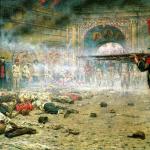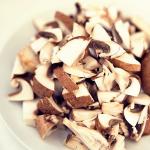The Isle of Wight is located just a few kilometers from the south coast of England and is considered a fashionable resort. Having been there, it immediately becomes clear why there is so much talk about this island: there are beautiful white sandy beaches, mysterious caves, and bizarrely shaped rocks. Yachting and many types of water sports are widely developed on the island. The wild nature of the island is in perfect harmony with medieval castles and churches.
By the way. On the Isle of Wight is the summer residence of Queen Victoria and Prince Albert, Osborne House, which provides the island with an additional influx of tourists.
You can only get to the island by sea. Take advantage of regular flights from (takes around two hours) or from nearby Portsmouth.
Isle of Wight attractions
Osborne House
Address: York Avenue, East Cowes, Isle of Wight - PO32 6JX, United Kingdom
Phone: +(44 198) 320 00 22
www.english-heritage.org.uk
Prices: adults - £13.4; children (5-15 years old) - £8; pensioners (from 60 years old) - 12.1 £
The former summer residence of Queen Victoria and Prince Albert, Osbourne House has long been a public place. At Osborne House Museum you can immerse yourself in the life of the royal couple and their nine children. Admire the Queen's private apartments, children's rooms, and after the museum you can stroll to the Royal Family's private beach. The walk will take you about 20 minutes, but the views from the path will make you forget about time, such is the amazing beauty of the Isle of Wight.
Ventnor Botanical Garden
Address: Undercliff Dr, Ventnor PO38 1UL, United Kingdom
Phone: +(44 198) 385 53 97
www.botanic.co.uk
Ventnor is a town on the south-east coast of the Isle of Wight. In 1970, on the site of the closed hospital, a Botanical Garden was laid out, which has no equal in all of England in terms of the number of subtropical plants growing there. The reason for this is that the climate of the Isle of Wight is more akin to the Mediterranean than to the typical British one. So in the Ventnor Botanical Garden you can see, for example, palm trees that are so uncharacteristic of England.
Needles Chalk Cliffs
Address: The Needles Park, Alum Bay, Isle of Wight PO39 0JD, United Kingdom
Phone: +(44 871) 720 00 22
www.theneedles.co.uk
Near the westernmost point of the Isle of Wight at the western end of Alum Bay are the Chalk, which translates as “Needles”. The rocks form a spit, going further and further into the sea, and on the last of them they even managed to build a lighthouse.
They can be reached by the Southern Vectis N7 bus from Newport or regular excursion routes from Yarmouth or Ryde.
Carisbrooke Castle
Address: Castle Hill, Newport, Isle of Wight PO30 1XY, United Kingdom
Phone: +(44 870) 333 11 81
www.english-heritage.org.uk
Prices: adults - 7.7 £; children (5-15 years old) - £4.6; pensioners (from 60 years old) - 6.9 £
Opening hours: depending on the month there are different operating modes, it is better to check on the website in advance.
Carisbrooke is one of the main attractions of the Isle of Wight, famous as the place where King Charles I was imprisoned after his defeat in the Civil War. The castle is perfectly preserved, and the surrounding fortress is one of the most worthy examples of fortification in medieval England.
There is a museum in the castle, and children can have fun dressing up in knight's armor and re-enacting historical battles.
If you need to get from one city on the Isle of Wight to another, we recommend
take advantage of the steam railway opened in the 19th century. In length
it is only 14 km, and the trains themselves look like they came straight out of a retro postcard.
Great Britain, being an island state, itself has several other small islands. One of these islands, which is also a separate unitary county, is the Isle of Wight (popularly called “England in miniature”).
Due to its location in the very south of Great Britain, White's history includes several moments when it became the front line of defense: during battles and battles between England and the continental states - during the war with France during the Napoleonic era and during the Second World War with the Germans.
The modern Isle of Wight is considered an attractive tourist and resort destination: the mild local climate (and Wight is considered the sunniest place in Great Britain) promotes the treatment of the circulatory and respiratory systems.
History of the island
White's history as an island dates back to the end of the Ice Age, when the water level in the World Ocean rose and flooded the existing straits that separate Great Britain from the continent, and the Isle of Wight itself from the island of Great Britain.
In ancient times, the Celts lived on the island, who were driven out from here by the Gauls around 50 BC, fleeing here from the Romans. The Romans arrived on the island only in the 1st century AD. and remained there until the 5th century. After them, the island came under the rule of the Germanic tribe of Jutes. In the 7th century, the Saxons annexed the Isle of Wight to the County of Hampshire.
White became an independent administrative unit only in 1890.
The Isle of Wight is considered the smallest county and the largest constituency by population. The population of the island is very proud of this fact. The patriotism of the inhabitants is so strong that many strive to achieve for the island a status similar to the Isle of Man, in which The island belongs to the crown possession of Great Britain, but is neither part of the state nor part of the European Union.

Local Attractions
Not only historical sites and architectural monuments, but also the nature of the county are worthy of attention here. It is rightly called an “Area of Outstanding Natural Beauty”, and the Isle of White receives this status due to the presence of special scenic spots. These include the Culver Cliffs near the town of Ryde and the white cliffs of the Needles (translated as Needles) in the west of the island.
The pointed chalk formations of the Needles are represented by three rock masses approximately 30 m in height. They are located in the Gulf of Alam and go out to sea. At the end of this line of rocks is a small lighthouse built in 1859. Previously, this cape was an important strategic target, but now it is only a tourist attraction. With the help of a lift, these free-standing rocks can be reached from the coastal cliffs.

Alam Bay is also famous for its multi-colored sand, but collecting it yourself from the rocks is prohibited. In local stores you can fill any purchased souvenir yourself with layers of sand of different colors. This tradition dates back to the reign of Queen Victoria. It was she who instilled in the entire English aristocracy the fashion for holidays on the Isle of Wight.
By the way, the residence of Queen Victoria and Prince Albert, Osborne House, is the most popular and visited attraction on the island. This is an entire palace, built in Italian style specifically as the summer residence of the queen and her family. After the queen's death here at Osborne House in 1901, her chambers became a family museum, and in 1921 they became publicly accessible. Osborne House is now a public museum.

Carisbrooke Castle also reminds of the royal family here.. It was built in the village of the same name in the southwest of Newport - the main city on the island - back in 1100. This is a well-preserved medieval fortress, which gained great fame after the imprisonment of Charles I here before his trial and execution. In 1898, Queen Victoria's youngest daughter Princess Beatrice founded a museum at the castle, and in 1914 she named Carisbrook her summer residence.

Among the religious sites of interest are the Church of St. Lawrence, the Church of St. Thomas, the Chapel of St. Catherine, and Quarre Abbey.
At the highest point of the White is the Tennyson Monument, dedicated to Alfred Tennyson, the popular poet, who was friends with Queen Victoria herself and her husband. From the site near the monument you can see almost the entire island.
Another attraction of the island is the operating steam railway. It is considered the oldest railway in England and still connects four stations.

Also located in the county is one of the oldest lighthouses in the country - St. Catherine's Lighthouse. It is located on Cape St. Catherine - the southernmost point of White. It was built back in 1323, and in its modern form was built in 1837 after the wreck of a ship near this place.

The Isle of Wight is considered to have the largest collection of dinosaur remains in Europe.
Water erosion has exposed ancient dinosaur remains on White's Cliffs, although they are usually very deep and inaccessible. It’s not for nothing that the Dinosaur Museum was opened here. The museum itself was designed by architects in the form of a huge pterosaur. The museum workers and local residents are especially proud of the almost complete skeleton of the neovenator found on the island.

On the Isle of Wight there is also an amusement park for children and adults - Blackgang China. There are attractions, cafes, shops and souvenir shops. Also, it is within the park that there is a local market.
Various interesting events take place in and around the county. For example, this is where the regatta is held, named after the first winner, the America's Cup. It was first held in 1851 among the yachts of the Royal Squadron and invited yachts. Subsequently, it began to be held as a race between the title defender and the new challenger, who must win the preliminary heats.

Also on the island in Robin Hill Park is the popular Bestival music festival., which is organized by the popular British DJ Rob da Bank. A special feature of the festival is that it takes place outdoors for several days. At the same time, about 50 thousand people live in tents on the same territory, like one big family.

To get to the “mainland” from White, you can use ferry services. The ferry island is connected to Portsmouth, Southampton and Lymington.
The Isle of Wight is the largest island in England.
It is located 5 km from the coast in the English Channel.
Great Britain and the island are separated by the Solent Strait. The island's capital city Newport.
Half an hour's walk from the center of Newport, Carisbrooke Castle sits on top of a hill.
The Roman invaders named the island Vectis, made it a stronghold on the British border and built a villa on this hill. The first mention of Carisbrooke Castle itself dates back to 1136.
It was then a Saxon fortified camp to protect England from Viking attacks. The Normans themselves, when they began to look for a suitable place for their fortifications, discovered that Carisbrooke could be an ideal place to defend the captured lands. As all the invaders said, the island is an ideal springboard for an attack on Britain, and whoever owns Carisbrooke Castle owns the island.
The castle was constantly being rebuilt, built on and strengthened. Possessions passed from hand to hand to proteges of kings and queens. The castle was besieged only twice - by King Stephen in 1136 and by the French in 1377. Since 1582, the castle began to belong to the crown and was controlled by governors. One of the most famous pages in Carisbrooke's history is the imprisonment of King Charles I by Cromwell in the castle in 1648. He lived here in captivity for several months and spent his time mainly trying to escape. Time did not preserve the chambers of the unfortunate king, but it did preserve the window from which Charles climbed out several times.
Now the castle still looks majestic and forbidding, especially from the foot of the hill. From the walls you can see “great” England in the distance... Everything is very quiet and peaceful, and you have to make an effort to feel the pressure of the passions of bygone eras.

There are different ways to get to White. Head down to Brighton and then along the coast to Portsmouth. You can go straight to Portsmouth, or you can get to Southampton. Ferries go from the coast to the island - passenger and cargo-passenger. The drive is not long - a couple of hours to the port and half an hour by water.
The island is a fairly civilized place, although provincial. They are used to tourists here; they don’t ask for documents at every step (only at the hotel during check-in). There is no need to fill your bag with medicines, clothes and sports equipment of all kinds - everything can be bought if necessary. However, we must remember that this is an island and it often gets cold in the evenings, and on the coast there is almost always a cool wind, so do not forget to take a sweater or windbreaker with you...
What really needs to be taken into account: not everywhere you can eat or buy something with a card, so you need to have enough cash with you.

There are also quite a few museums on White. Marine - in Cowes, boat - in Newport, planetarium in Yarmouth. A Pearl Museum was built not far from Brighton, and a zoo was built near Sandown. There is also a Museum of miniature antique dolls and toys, an old forge, the only surviving windmill on the island, a Piracy Museum and botanical gardens in Ventnor. And on the island you can rent horses, boats, bicycles and even sports equipment and go on foot, horseback and swim to explore the surrounding area.
You can stay on the island at a hotel or campsite. The bulk of hotels are located in resort towns along the coast, and campsites are located between them. If you are traveling by car, it is good to stay on the coast. You won’t need a lightweight tent with aluminum poles; there are trailers everywhere in the campsites, so you don’t have to take it with you. If you walk, it’s easier - stop in the center of the island, that is, in the town of Newport.
But since this is one of the most popular English resorts, it is better to arrange an order from Moscow. And in advance. Sometimes you have to wait a week for a response to a request. At the English embassy you will also need to present a fax from the hotel with confirmation of your reservation.
Seven months ago I already published one of my days in London. Today we will take a walk along the picturesque Isle of Wight, blown by sea winds. I am publishing the last day of our vacation (out of 5 days) on the island, because it is the only one documented inside and out, although there are much more interesting and exciting places on the island - I will write about them later.
Come with us!
1. Get up at 8.00. I turn on the TV to see the weather forecast for today. Do you see the town of Newport on the map? This is the island we are on.
2. I look out the window to make sure that the weather forecasters are not lying: there is no rain. Then I take a shower and collect our travel bags, since today we are leaving the hotel and going to breakfast.
3. It’s very pleasant to travel out of season: there are practically no people and prices are low. The service staff consists mainly of people from Eastern Europe. Most tourists on the island in winter are English pensioners.
4. We leave our bags at the reception and hit the road.
5. From the town of Sandown there is very convenient communication with the capital of the island and its north-eastern region.
6. Short distances and camping opportunities make it convenient to travel around the island by car.
7. Our hotel in Sandown was located right on the seashore.
8. We enter Ryde - from the second floor window of the bus you can see the whole city and even a piece of the Solent. There is a very developed network of double-decker buses throughout the island and their pricing policy: 10 pounds for 24 hours, 15 pounds for 48 hours.
9. Antiquity, modernity and original style - this is all about the Isle of Wight.
10. We arrived at the steam railway, which has three stations. During the tourist season, you can take a fascinating trip on a retro train. We wanted to walk along the sleepers to the next station, but repairs were going on on the tracks, and the workers did not let us through :)
11. Out of season you have to be content with looking at retro posters and train schedules from the early 20th century.
12. For the first time during my entire stay in England, we saw preparations for a beautiful funeral. This is quite an expensive pleasure here; apparently they were burying someone from a very rich family.
13.If there weren’t a modern car in the frame, you’d think we were in the 19th century.
14. The roads on the island are very narrow, local truck and bus drivers should be given medals :)
15. Sign along the road "You've just passed a fantastic pub serving great beer and home-cooked food!"
16. Another nice English mailbox - there are many types.
17. Rural house - the calling card of Isle Of Wight - an agricultural and tourist island. The vast majority of the population on the island is white.
18. Star of hippie times - Volkswagen T2, in delicate girlish “makeup”.
19. The village of Godshill ("God's Hill"), where 6 original thatched houses and a 14th century church have been preserved.
20. Palm trees on the Isle of Wight are more vibrant than on the Mainland (main island) of Great Britain.
21. The next stop for our walk is the incredibly beautiful, poetically picturesque, meditative and tranquil town of Ventnor.
22. Ventnor - a town on the hills. Its roads and views somewhat reminded us of the city of Ooty in southern India.
23. It’s strange that this pier in Ventnor is not mentioned anywhere - an incredibly charming place!
24. Man-made waterfall in the same place.
25. We take a walk along the embankment. Everything is fine, but the wind is very strong.
27. Light from heaven on a cloudy day! Surprisingly, during the 5 days of our trip it never rained.
28. Low tourist season - the streets are deserted...
29. ...and the whole island is just for us!
30. You will always get this feeling if you go to the Isle Of Wight in February.
31. There are many yacht clubs, as well as small boat coves.
32. Hygieia - goddess of health in Greek mythology.
33. The shore is thoroughly fortified.
34. On White, as throughout England, there are benches with memorial or simply nameplates.
35. Somewhere over there, across the sea - Europe...
36. The dog-cop in the window looks at us melancholy as we return to Sandown to pick up our things. In half an hour we get to the “base” by bus.
37. In Sandown we went for tea in a cozy home cafe. There is 1 hour left before the train to Ryde.
38. During this time we sat in a cafe and walked along the beach.
39. Walking around the Isle of Wight is a real pleasure. The sea can be felt everywhere, even if it is not visible. You can walk it from east to west in 8 hours, and from south to north in 4 and a half.
40. What sun in winter in Britain, what beaches, what rocks and waves - ah!..
41. The East Bank railway has only 8 stations and very old trains, similar to the London Underground. In general, it felt like the whole island was frozen in time many years ago.
42. It’s getting dark. In the town of Ryde we finish our last day on the island.
43. The pier extends towards Portsmouth, a city in the main British territory.
44. It seemed to us that Ryde had the most life on the island - on a par with the capital, Newport.
England in miniature| BASIC INFORMATION |
| Date of formation | end of the Pleistocene period |
| Location | UK, English Channel |
| County | Isle of Wight |
| Square | 381 km2 |
| Highest point | Mount St. Boniface (241 m) |

Isle of Wight - “England in miniature”, “the diamond in the crown of the English Empire”. These epithets are awarded to the English island and county in the English Channel by tourists who have visited here. Mysterious caves and bizarre rocks coexist with beautiful beaches, ancient castles and churches, and the sails of yachts whiten above the water surface. 
The fashionable resort of White is a small island a few kilometers off the south coast of England, the smallest county in Great Britain and the sunniest place in Albion. Therefore, a holiday on the Isle of Wight is good at any time of the year.
This paradise is recognized as an "Area of Outstanding Natural Beauty". Here, wild nature and man-made wonders are closely intertwined, creating a harmonious picture. Medieval castles and Victorian buildings rise against a backdrop of mountains and wild forest, beautiful sandy beaches for tourists juxtapose with bare rocky coastal strips. 
This is one of the most fashionable places in the British Isles. 2.6 million tourists come here every year to see Osborne House, the seaside residence of Queen Victoria and Prince Albert.
The royal offspring played in a Swiss cottage specially built for them. It is now home to a museum that is part of Osborne House. In addition, one of the main exhibits of the museum is the royal bath. The construction contract was won by Thomas Cubitt, who was simultaneously engaged in the reconstruction of Buckingham Palace. The Queen's grandchildren were raised at Osborne House, including the last Russian Empress Alexandra Feodorovna.
Near the palace there is a chalet, transported at the request of the queen to the shores of the Solent from Switzerland. In 1901, Queen Victoria died at Osborne House and her private apartments were turned into a family museum. Victoria's heir, Edward VII, opened a naval school on the estate, where he sent his sons to study.

The Isle of Wight has the Needles rock formations. The cape is located on the western edge of the island, in Alum Bay. It consists of a series of picturesque chalk cliffs jutting out of the sea. At the end of the cape there is a small lighthouse built in 1859 by Scottish engineer James Walker. The name of the rock formations comes from their shape, which resembles needles sticking out of the water. Lot's Wife was once the tallest "needle", but then it was destroyed by a storm in 1764. The cape became an important military target in the 19th century, and an artillery battery guarded the area until 1954; now it's just a tourist attraction. The rock formations can be reached by lift from the coastal cliffs.

Alum Bay is known for its colorful sands and glassblowing workshops. Collecting sand from the rock is not allowed, but in nearby shops you can fill any souvenir with layers of multi-colored sand yourself. This interesting tradition dates back to Queen Victoria.
Carisbrooke Castle also reminds of the Royal presence on the island. One of the most remarkable examples of fortification in the British Isles.
In the center there is a very well-preserved medieval fortress of the 11th-13th centuries. It is surrounded by artillery bastions built at the end of the 16th century. one of Elizabeth's close associates, Sir George Carey. However, the castle gained its main fame again during the Civil War, or rather immediately after it. It was here that Charles I fled in the hope of negotiating in parliament. However, instead the castle became his prison. Here Charles spent the fourteen months leading up to his trial. He tried to escape from here too, but got stuck in the window. 
"Little England", as the Isle of Wight is often called, is an ideal destination for sea lovers and those actively involved in sports. The island is especially popular among yachtsmen. A regatta around the Isle of Wight is held annually. Its participants include many titled persons, members of the royal family and ordinary fans of this sport. Today, many sailing yachts arrive at the Isle of Wight. 
The smallest railway in the UK runs across the island - the tiny 14-kilometer Island Line, stretching from Ryde to Shanklin. Being the oldest railway, it is considered one of the main attractions of this beautiful island. 
The Isle of Wight is one of the richest sites for dinosaur remains in Europe. The island's prehistory is represented on Dinosaur Island, a museum built in the shape of a huge pterosaur by local architects. The museum opened in 2001. The museum is especially proud of the nearly complete skeleton of a neovenator dinosaur found on the island.

Like many areas of Great Britain, the island has its own dialect of English. The island has hosted a music festival of the same name every year since 2002, and the Bestival music festival since 2004.
In addition to the carefully selected musical acts who come to the Isle of Wight each year to “hang out” and perform for music lovers, the festival has another quintessentially British feature: it’s a campsite event, meaning you can (and should, in fact) bring your own sleeping tents to spend this weekend in one big happy family. On the other hand, you can use the services of the festival organizers and move into ready-made tents, which stand in neat blue rows on the green Scottish grass.Every year the festival is visited by tens of thousands of people.

The island is an important tourist site and is connected to the mainland by several ferry crossings. There are ferry services to the island from Southampton, Portsmouth and Lymington. 


















